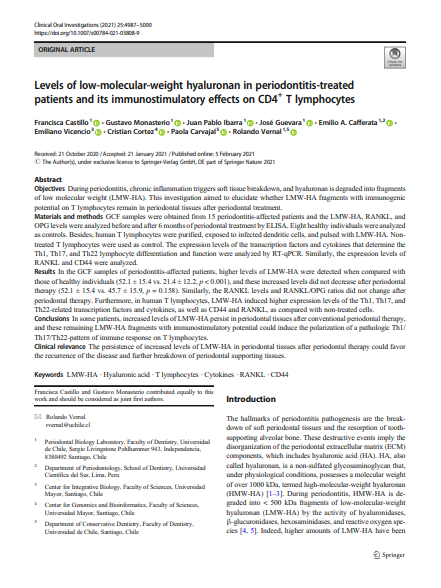Levels of low-molecular-weight hyaluronan in periodontitis-treated patients and its immunostimulatory effects on CD4+ T lymphocytes

Fecha
2021-02-26Autor
Castillo, Francisca
Monasterio, Gustavo
Ibarra, Juan
Guevara, José
Cafferata, Emilio A.
Carvajal, Paola
Vernal, Rolando
Vicencio, Emiliano [Univ Mayor, Fac Sci, Ctr Integrat Biol, Chile]
Cortez, Cristian [Univ Mayor, Fac Sci, Ctr Genom & Bioinformat, Chile]
Ubicación geográfica
Notas
HERRAMIENTAS
Acceda a títulos restringidos
¿Cómo descargar?Resumen
Objectives During periodontitis, chronic inflammation triggers soft tissue breakdown, and hyaluronan is degraded into fragments of low molecular weight (LMW-HA). This investigation aimed to elucidate whether LMW-HA fragments with immunogenic potential on T lymphocytes remain in periodontal tissues after periodontal treatment. Materials and methods GCF samples were obtained from 15 periodontitis-affected patients and the LMW-HA, RANKL, and OPG levels were analyzed before and after 6 months of periodontal treatment by ELISA. Eight healthy individuals were analyzed as controls. Besides, human T lymphocytes were purified, exposed to infected dendritic cells, and pulsed with LMW-HA. Non-treated T lymphocytes were used as control. The expression levels of the transcription factors and cytokines that determine the Th1, Th17, and Th22 lymphocyte differentiation and function were analyzed by RT-qPCR. Similarly, the expression levels of RANKL and CD44 were analyzed. Results In the GCF samples of periodontitis-affected patients, higher levels of LMW-HA were detected when compared with those of healthy individuals (52.1 +/- 15.4 vs. 21.4 +/- 12.2, p < 0.001), and these increased levels did not decrease after periodontal therapy (52.1 +/- 15.4 vs. 45.7 +/- 15.9, p = 0.158). Similarly, the RANKL levels and RANKL/OPG ratios did not change after periodontal therapy. Furthermore, in human T lymphocytes, LMW-HA induced higher expression levels of the Th1, Th17, and Th22-related transcription factors and cytokines, as well as CD44 and RANKL, as compared with non-treated cells. Conclusions In some patients, increased levels of LMW-HA persist in periodontal tissues after conventional periodontal therapy, and these remaining LMW-HA fragments with immunostimulatory potential could induce the polarization of a pathologic Th1/Th17/Th22-pattern of immune response on T lymphocytes.
URI
https://repositorio.umayor.cl/xmlui/handle/sibum/9090https://link-springer-com.bibliotecadigital.umayor.cl:2443/content/pdf/10.1007/s00784-021-03808-9.pdf
https://doi.org/10.1007/s00784-021-03808-9
Coleccion/es a la/s que pertenece:
Si usted es autor(a) de este documento y NO desea que su publicación tenga acceso público en este repositorio, por favor complete el formulario aquí.